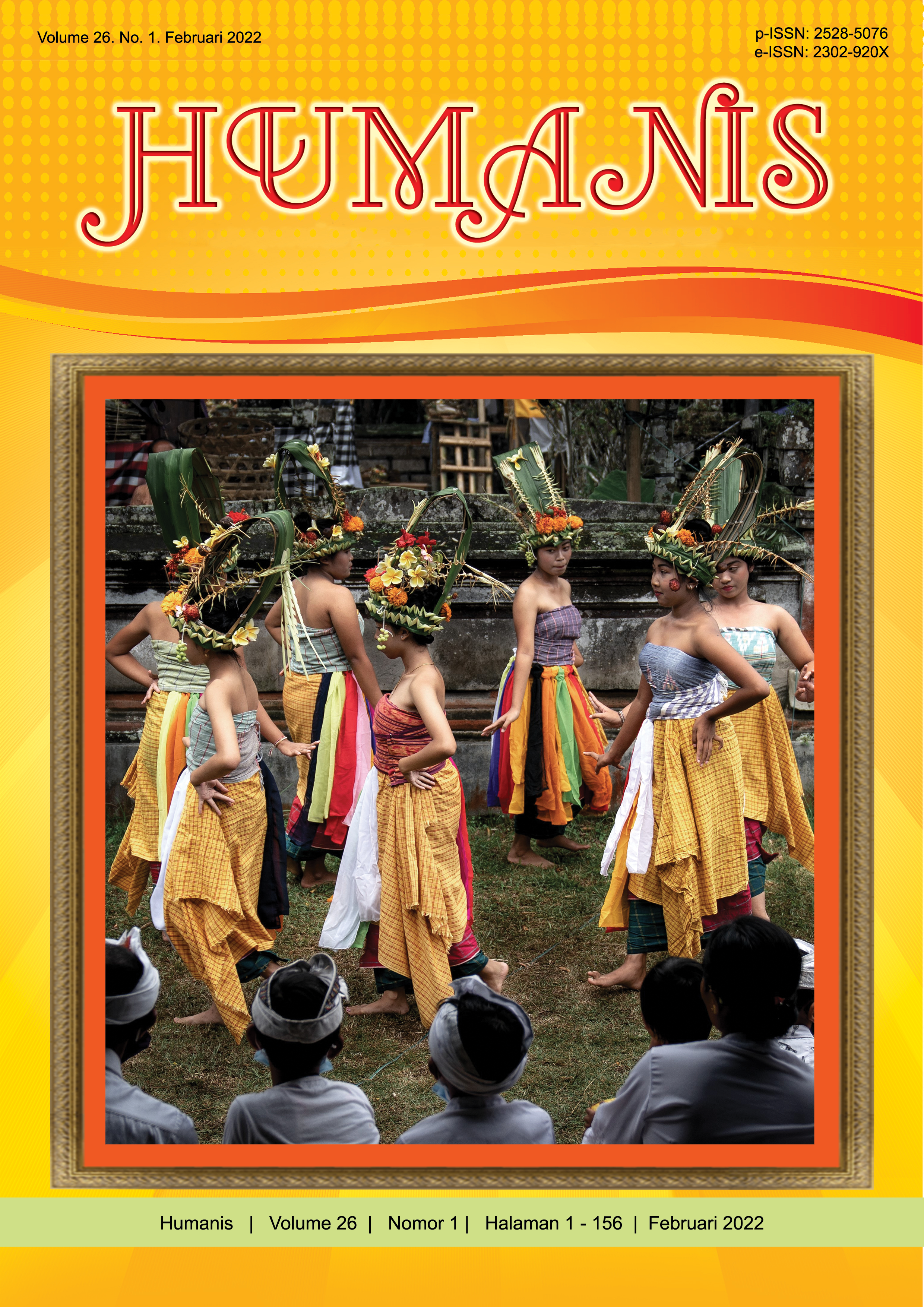Produktivitas Sufiks -te dan -shu dalam Bahasa Jepang
Abstract
This study is a corpus-based analysis that aims to investigate the productivity of the -te and -shu suffixes as agent-forming suffixes in Japanese as well as the structure of noun formation by adding these two suffixes. The theories used in this research are the theory of productivity by Baayen (1992) and the theory of Japanese morphology by Tsujimura (2013). Based on the results of the analysis on the Japanese News 2020 100K corpus, it was found that the suffix -te is more productive as a form of agent nominals. The suffix -te when attached to an infinitive verb denotes a person who conducts a certain action while the suffix -shu when attached to a Sino-Japanese verbal noun, noun, or bound morphemes denotes one’s profession.
Downloads
References
Baayen, R. H. (1992). Quantitative Aspect of Morphological Productivity. Booij, G. E. and van Marle, J. (eds); Yearbook of Morphology 1991, pp. 109–149. Kluwer Academic Publishers, Dordrecht.
Baker, Paul. (2010). Corpus Methods in Linguistics. In Litosseliti Lia (Ed.), Research Methods in Linguistics. (pp. 93-113). Continnum International Publishing Group.
Bauer, L. (2001). Morphological Productivity (Cambridge Studies in Linguistics). Cambridge: Cambridge University Press.
Booij, G. (2007). The Grammar of Words. Oxford: Oxford University Press.
Creswell, J. W., & Cresswell, D. (2018). Research design : Qualitative, quantitative, and mixed methods approaches. (5th ed). Los Angeles: SAGE.
Denistia, K. & Baayen, R. H. (2019). The Indonesian prefixes PE- and PEN-: A study in productivity and allomorphy. Morphology. https://doi.org/10.1007/s11525-019-09340-7
Desagulier, G. (2017). Corpus Linguistics and Statistics with R: Introduction to Quantitative Methods in Linguistics. New York: Springer.
Goldhahn, D., Eckart, T. & Quasthoff, U. (2012). Building large monolingual dictionaries at the Leipzig Corpora Collection: From 100 to 200 languages. In Proceedings of the 8th Language Resources and Evaluation Conference (LREC) 2012, 759–765. Istanbul. http://www.lrec-conf.org/proceedings/lrec2012/pdf/327_Paper.pdf
Gries, S. (2009). Statistics for Linguistics with R: A Practical Introduction. Berlin, New York: De Gruyter Mouton. https://doi.org/10.1515/9783110216042
Ishida, M. (2020). RMeCab : parsing Japanese texts with mecab-0.996 / R-4.0.3. R Package version 1.05. Retrieved from https://github.com/IshidaMotohiro/RMeCab
Kageyama, T. & Saito, M. (2016). 1. Vocabulary strata and word formation processes. In T. Kageyama & H. Kishimoto (Ed.), Handbook of Japanese Lexicon and Word Formation (pp. 11-50). Berlin, Boston: De Gruyter Mouton. https://doi.org/10.1515/9781614512097-005
Kishimoto, H. (2016). 19. Idioms. In T. Kageyama & H. Kishimoto (Ed.), Handbook of Japanese Lexicon and Word Formation (pp. 665-702). Berlin, Boston: De Gruyter Mouton. https://doi.org/10.1515/9781614512097-023
Kobayashi, H., Yamashita, K. & Kageyama, T. (2016). 3. Sino-Japanese words. In T. Kageyama & H. Kishimoto (Ed.), Handbook of Japanese Lexicon and Word Formation (pp. 93-132). Berlin, Boston: De Gruyter Mouton. https://doi.org/10.1515/9781614512097-007
Kudou, T. (2013). MeCab: Yet Another Part-of-Speech and Morphological Analyzer. Available from https://taku910.github.io/mecab/
Lieber, R. (2009). Introducing Morphology (Cambridge Introductions to Language and Linguistics). Cambridge University Press. doi:10.1017/CBO9780511808845
McEnery, T., & Hardie, A. (2012). Corpus Linguistics: Method, Theory and Practice (Cambridge Textbooks in Linguistics). Cambridge University Press. https://doi.org/10.1017/CBO9780511981395
Ono, N. (2016). 17. Agent nominals. In T. Kageyama & H. Kishimoto (Ed.), Handbook of Japanese Lexicon and Word Formation (pp. 559 - 630). Berlin, Boston: De Gruyter Mouton. https://doi.org/10.1515/9781614512097-021
R Core Team. (2020). R: A Language and Environment for Statistical Computing. Vienna, Austria. Retrieved from https://www.R-project.org/
RStudio Team. (2020). RStudio: Integrated Development Environment for R. Boston, MA. Retrieved from http://www.rstudio.com/
Rajeg, G. P. W. & Denistia, K. (2021). A study in productivity of Indonesian causative per- and -kan. figshare. Presentation. https://doi.org/10.6084/m9.figshare.14633133.v3
Rajeg, G. P. W. (2020). Tutorial AntConc. [Video]. YouTube. https://www.youtube.com/playlist?list=PL6kE55FBuZnVj2SOrx75o99lFiPq_TmCt
Sugiyono. (2013). Metode Penelitian Kuantitatif, Kualitatif, dan R&D. Bandung: Alfabeta
Sugioka, Y. & Ito, T. (2016). 10. Derivational affixation in the lexicon and syntax. In T. Kageyama & H. Kishimoto (Ed.), Handbook of Japanese Lexicon and Word Formation (pp. 347-386). Berlin, Boston: De Gruyter Mouton. https://doi.org/10.1515/9781614512097-014
Tsujimura, N. (2013). An Introduction to Japanese Linguistics (3rd ed.). Malden: Wiley Blackwell.
Yule, G. (2010). The Study of Language (4th ed.). Cambridge: Cambridge University Press. doi:10.1017/CBO9780511757754


















